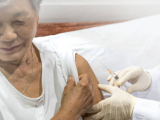Oct 17, 2006 (CIDRAP News) – Low doses of a cell-based avian flu vaccine triggered a good immune response to the H5N1 avian influenza virus, according to preliminary results of a clinical trial by Baxter International of Deerfield, Ill., maker of the vaccine.
The vaccine induced an immune response not only against the targeted H5N1 strain, but against other strains as well, according to Baxter. The company announced results of the phase I/II trial Oct 4 but had not released study data until Oct 11, at the World Vaccine Congress in Lyon, France.
"This is the first clinical demonstration that a candidate H5N1 vaccine can induce antibodies that neutralize widely divergent strains of H5N1," said Hartmut Ehrlich, MD, vice president for global research and development, in an Oct 4 Baxter news release. He added that the data "suggest that the vaccine may provide wider protection for a larger number of people before and during a pandemic."
The vaccine was produced using Baxter's vero cell–based technology and dead whole viruses of wild-type H5N1 avian influenza strain A/Vietnam/1203/2004.
Cell-based vaccines are grown in mammalian cells (often from kidneys) instead of chicken eggs and in theory could help meet "surge capacity" needs because the cells can be frozen for stockpiling. The method also can shave about a month off the production time for flu vaccines, which is normally about 6 months. But cell-based flu vaccines face practical hurdles, as discussed below.
The cell-based vaccine was administered to 270 healthy adults aged 18 to 45 in Austria and Singapore. Groups of 44 to 48 volunteers received either 3.75, 7.5, 15, or 30 micrograms (mcg) of the vaccine with an aluminum oxide adjuvant, a substance that stimulates immune response. Two other groups of 45 each received 7.5 or 15 mcg of vaccine without an adjuvant. All volunteers were vaccinated on the first day of the trial and again 21 days later.
Three weeks after the second injection, testing of serum samples showed that 15 of 23 (65%) volunteers in the 3.75-mcg group had a strong antibody response to the vaccine virus (microneutralization titer 1:20 or higher). In comparison, 15 in 20 (75%) of the adjuvanted 7.5-mcg group and 22 of 27 (82%) of the nonadjuvanted 7.5-mcg group showed a strong antibody response.
The vaccine also showed evidence of cross-protection against other H5N1 strains. Microneutralization testing for antibody response to a 1997 Hong Kong strain showed a 71% (12 of 17) rate of response in the 3.75-mcg group, compared with an 81% (13 of 16) and a 96% (21 of 22) response in the adjuvanted and nonadjuvanted 7.5-mcg groups, respectively.
For a 2005 H5N1 strain from Indonesia, the rates of antibody response were 35% (6 of 17), 63% (10 of 16), and 68% (15 of 22), respectively.
Commenting on the diverse makeup of these nontargeted H5N1 viruses, Ehrlich told CIDRAP News via e-mail, "They are strains that are substantially different from Vietnam 1203. One is the same clade [family] but emerged 7 years earlier; the other one is a different clade. [This is] in contrast to many other strains—for example, Vietnam 1194—which are very similar to Vietnam 1203 and are expected to therefore induce cross-neutralization . . . and were indeed protective in our animal studies."
Ehrlich, who presented the data in Lyon, said the serum samples from the volunteers who received 15 or 30 mcg of the vaccine had not yet been analyzed. Final results of the study will be available by the end of the year, according to the Baxter news release.
The rate of adverse events, released this week, demonstrated the apparent safety of the vaccine. After two injections, 3% of patients (6 of 201) had fever, 6.0% (12 of 201) experienced malaise, and 3.5% (7 of 201) reported shivering, the company said.
Commenting on the implications of the findings, infectious-disease expert Michael T. Osterholm, PhD, MPH, said Baxter's vaccine—like other H5N1 vaccines in development—is a long way from offering an early solution to the threat of a flu pandemic. Osterholm is director of the University of Minnesota Center for Infectious Disease Research and Policy, publisher of the CIDRAP Web site.
Aside from the problem that it will take months to develop a specific vaccine once a pandemic strain of flu emerges, the Food and Drug Administration has not yet approved any cell-culture flu vaccine, Osterholm told CIDRAP News. "In fact, they're a long ways from licensure," he said.
In addition, efforts to use a vaccine during a pandemic will encounter a host of practical problems, he added. "We have to think of the whole supply chain. What about syringes? Will they be available when a pandemic hits? What about a whole host of supplies that we'll need during a pandemic that won't be available because of our just-in-time infrastructure?
"These practical considerations are so crucial that, if all these new vaccines were released today, none of them would make the world a safer place."
Baxter said it plans to begin phase III trials of the vaccine early next year.
Baxter is collaborating with DynPort Vaccine Corp. to develop cell-based vaccines. In May, the US Department of Health and Human Services awarded DynPort a $41 million contract for cell-based flu vaccine work. The funds came from $3.3 billion that Congress appropriated for pandemic preparedness last December.
See also:
Baxter news release
http://www.rxpharmacy.md/news/baxter_announces_safety_and_immunogenicity_results_from_phase_i_ii_clinical_trial_of_cell_based_candidate_h5n1_pandemic_vaccine.html
May 4 CIDRAP News story "US awards $1 billion for cell-based flu vaccines"
Jun 27, 2005, CIDRAP News story "Momentum builds for cell-culture flu vaccines"
















